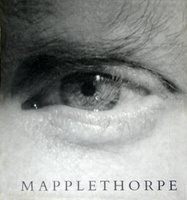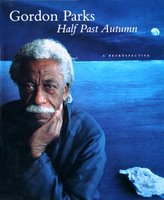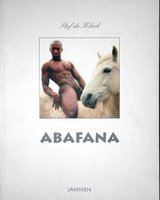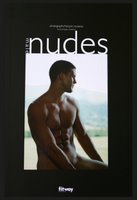 Irving Penn, was one of the first photographers I took notice of. For over 50 years he has helped define the modern portrait and was one of the original photographers who helped define Vogue Magazines style of fashion photography. From fashion to portraits of celebrities to African tribesmen, Penn has done it all and his images are still relevant today!
Irving Penn, was one of the first photographers I took notice of. For over 50 years he has helped define the modern portrait and was one of the original photographers who helped define Vogue Magazines style of fashion photography. From fashion to portraits of celebrities to African tribesmen, Penn has done it all and his images are still relevant today! Starting with her early work with Rollingstone Magazine, Annie Leibovitz has created a style of portrait photography that carefully poses the subject into a situation which carries a larger story in and around the subject. you could almost say a single image biography, capturing the essence of the subject. Infamous is the image of Whoopie Goldberg laying in a tub of milk with arms and legs, locks jutting right and left and her comedic face poking out of the white liquid. An iconic Kieth Haring nude but painted white in an all white room with his signature illustrations covering all, this could be the first time an artist has ever inserted himself into his own canvas!
Starting with her early work with Rollingstone Magazine, Annie Leibovitz has created a style of portrait photography that carefully poses the subject into a situation which carries a larger story in and around the subject. you could almost say a single image biography, capturing the essence of the subject. Infamous is the image of Whoopie Goldberg laying in a tub of milk with arms and legs, locks jutting right and left and her comedic face poking out of the white liquid. An iconic Kieth Haring nude but painted white in an all white room with his signature illustrations covering all, this could be the first time an artist has ever inserted himself into his own canvas! In early 2000 I attended the exhibit of Annie Leibovitz: Women at Washington D.C.'s Corcoran Gallery. The large oversized prints of Women both famous and not captured the full experience of womanhood. I was struck in awe by two of the images, one of tennis's Williams sisters, singularly proud and dominating, and one of the first Woman Space Shuttle commander Eileen Collins in her full orange flight suit,on the tarmac at the Houston Space Flight Center. Simply amazing!
In early 2000 I attended the exhibit of Annie Leibovitz: Women at Washington D.C.'s Corcoran Gallery. The large oversized prints of Women both famous and not captured the full experience of womanhood. I was struck in awe by two of the images, one of tennis's Williams sisters, singularly proud and dominating, and one of the first Woman Space Shuttle commander Eileen Collins in her full orange flight suit,on the tarmac at the Houston Space Flight Center. Simply amazing! I remember contacting the Robert Miller Gallery in the early 80's to inquire about purchasing a Robert Mapplethorpe image. I remember asking to speak with someone and getting "They are not here!" followed by a dial tone. When calling back the next day, I got someone who explained that Robert had hung up on me, "Robert Miller?" I asked.
I remember contacting the Robert Miller Gallery in the early 80's to inquire about purchasing a Robert Mapplethorpe image. I remember asking to speak with someone and getting "They are not here!" followed by a dial tone. When calling back the next day, I got someone who explained that Robert had hung up on me, "Robert Miller?" I asked."No Mapplethorpe" was the answer. Wow I had been hung up on by a real New York Icon!!! ...what an ass. I also attended "The Perfect Moment" at the Chicago Museum of Contemporary Art just a few months before he passed away. I was blown away by the platinum printed images who's production values added to the already powerful compositions. While watching a documentary shown there, I found his explanation of the man in the polyester suit to be fascinating... Robert said the piece illustrated Americas discomfort with the big black penis... he continued to explain that the average viewer will start at the outer edges of the print and slowly circle the image in a clockwise spiral until they are forced to confront the penis in the center. I ran out to the floor and indeed everyone viewing the rather large image had their heads spinning into the center. While I have learned some pretty objectionable truths about Robert Mapplethorpe the man, I have to give him credit for introducing many concepts that have challenged the status quo.
 Herb Ritts is probably the photographer on this list that has influenced me the most. Notorious is formatted very large, thus carrying the metaphor of the celebrities within, large and Iconographic! The cover is a close up of perhaps one of the biggest mouths in Hollywood Sandra Bernhardt.
Herb Ritts is probably the photographer on this list that has influenced me the most. Notorious is formatted very large, thus carrying the metaphor of the celebrities within, large and Iconographic! The cover is a close up of perhaps one of the biggest mouths in Hollywood Sandra Bernhardt. Herb Ritts began his photographic career in the late 70's. Initially, he shot informal portraits of friends in the movie industry, and since gained a reputation as a master photographer of artists, athletes, political figures, actors, musicians and fashion personalities. In addition to working in the editorial field for publications like Vogue, Vanity Fair and Rolling Stone, Ritts directed numerous music videos and commercials, and created memorable advertising campaigns for Giorgio Armani, Chanel, Donna Karan, Gianni Versace, Calvin Klein, Polo Ralph Lauren and others. His fine art photography has been the subject of solo exhibitions in Los Angeles, New York, London, Boston, Vienna, Hamburg, Rome, Tokyo and Milan. Herb Ritz once said "In order to be a great photographer, you have to be a diplomat, a psychologist, a playmate and a great persuader"
Herb Ritts began his photographic career in the late 70's. Initially, he shot informal portraits of friends in the movie industry, and since gained a reputation as a master photographer of artists, athletes, political figures, actors, musicians and fashion personalities. In addition to working in the editorial field for publications like Vogue, Vanity Fair and Rolling Stone, Ritts directed numerous music videos and commercials, and created memorable advertising campaigns for Giorgio Armani, Chanel, Donna Karan, Gianni Versace, Calvin Klein, Polo Ralph Lauren and others. His fine art photography has been the subject of solo exhibitions in Los Angeles, New York, London, Boston, Vienna, Hamburg, Rome, Tokyo and Milan. Herb Ritz once said "In order to be a great photographer, you have to be a diplomat, a psychologist, a playmate and a great persuader" In late 1941 Parks became the first photographer to receive a fellowship from the Julius Rosenwald Foundation and chose to work with Roy Stryker at the Farm Services Administration (FSA), a government agency designed to call attention to the plight of the needy during the Depression and to create an historical record of social and cultural conditions across the country. He joined FSA in January, 1942, moving his family to Washington, DC, where he encountered a city divided by race and class. In 1999 Gordon Parks retrospective "Half Past Autumn" began to tour the country and i was able to see it at The Detroit Institute of Arts.
In late 1941 Parks became the first photographer to receive a fellowship from the Julius Rosenwald Foundation and chose to work with Roy Stryker at the Farm Services Administration (FSA), a government agency designed to call attention to the plight of the needy during the Depression and to create an historical record of social and cultural conditions across the country. He joined FSA in January, 1942, moving his family to Washington, DC, where he encountered a city divided by race and class. In 1999 Gordon Parks retrospective "Half Past Autumn" began to tour the country and i was able to see it at The Detroit Institute of Arts.  Andreas Bitesnich Started shooting in the late 80's and entered the public view with this volume called nudes. I was truck by the interplay of his models, with many of the images showing posses with men and women in improbable groupings. The images of Roy shot in Vienna caught my eye the most. Roy is imaged in jet-black nudes against the striking pure white backgrounds. Many of the images challenging the viewer into questioning just what is masculinity.
Andreas Bitesnich Started shooting in the late 80's and entered the public view with this volume called nudes. I was truck by the interplay of his models, with many of the images showing posses with men and women in improbable groupings. The images of Roy shot in Vienna caught my eye the most. Roy is imaged in jet-black nudes against the striking pure white backgrounds. Many of the images challenging the viewer into questioning just what is masculinity. Originally from Ireland, John Healy now makes New York City his home and stage for artistic creativity. He thrives on the dynamics of that city, especially its racial diversity. As he relates, "I like New York because of the ethnic mix. If I still lived in Ireland it’d be all redheads and freckles.” This blends into one of his current themes of trying to represent the beauty that he finds in black people and other minority groups that are so prevalent in America but so rare in his homeland. I had the opportunity to exchange e-mails with John a few years back... he is an interesting and engaging person.
Originally from Ireland, John Healy now makes New York City his home and stage for artistic creativity. He thrives on the dynamics of that city, especially its racial diversity. As he relates, "I like New York because of the ethnic mix. If I still lived in Ireland it’d be all redheads and freckles.” This blends into one of his current themes of trying to represent the beauty that he finds in black people and other minority groups that are so prevalent in America but so rare in his homeland. I had the opportunity to exchange e-mails with John a few years back... he is an interesting and engaging person.  While I have never been a big fan of the disembodied nude image, this volume by Wangenhiem is unique in as much as he uses the forces of nature, in this case water and sand to help bring contrast and definition to the male body. As the volume is written in German, I had hoped to learn more about him on the net, but it seems there is not much written about this photographer that could help shed light on what he wanted to say with his work. We are left with only some extraordinary images.
While I have never been a big fan of the disembodied nude image, this volume by Wangenhiem is unique in as much as he uses the forces of nature, in this case water and sand to help bring contrast and definition to the male body. As the volume is written in German, I had hoped to learn more about him on the net, but it seems there is not much written about this photographer that could help shed light on what he wanted to say with his work. We are left with only some extraordinary images. Despite being blind in one eye, such is Watson's success with magazines such as Vogue, Rolling Stone, The Face, Vibe, Life and Newsweek that it is said there is never a day goes by without a Watson photograph on the cover of a major magazine somewhere in the world. He acted as photographer at the wedding of Prince Andrew and Sarah Ferguson and has been involved in advertising campaigns of many of the world's leading clothing and cosmetics companies.
Despite being blind in one eye, such is Watson's success with magazines such as Vogue, Rolling Stone, The Face, Vibe, Life and Newsweek that it is said there is never a day goes by without a Watson photograph on the cover of a major magazine somewhere in the world. He acted as photographer at the wedding of Prince Andrew and Sarah Ferguson and has been involved in advertising campaigns of many of the world's leading clothing and cosmetics companies.This volume entitles Cyclops is the culmination of a great deal of his work.
 Tom Bianchi started his professional life as a lawyer, trained at Northwestern University. He worked as corporate counsel for Columbia Pictures. Came the day when he tore up his law degree and pasted the scraps into a painting, entitled ESQ: Notes From a Lawyer Who Left. Since then, Bianchi has produced photographs, paintings, and sculptures that have been exhibited and collected throughout the world. He published his first book of photographs in 1991. "I'm not interested in people who want to be 'models.' I like working with men who want to explore themselves more deeply - and erotically - and have some fun in the process." Bianchis’ work proofs his believes.
Tom Bianchi started his professional life as a lawyer, trained at Northwestern University. He worked as corporate counsel for Columbia Pictures. Came the day when he tore up his law degree and pasted the scraps into a painting, entitled ESQ: Notes From a Lawyer Who Left. Since then, Bianchi has produced photographs, paintings, and sculptures that have been exhibited and collected throughout the world. He published his first book of photographs in 1991. "I'm not interested in people who want to be 'models.' I like working with men who want to explore themselves more deeply - and erotically - and have some fun in the process." Bianchis’ work proofs his believes. Rare to the list is a black female photographer with an interesting perspective on the human form. Rundu Staggers has defined not only a style but singlehandedly a marketing strategy to get her work out to the public. Calenders and video presentations as well as her books are hightly saught out.
Rare to the list is a black female photographer with an interesting perspective on the human form. Rundu Staggers has defined not only a style but singlehandedly a marketing strategy to get her work out to the public. Calenders and video presentations as well as her books are hightly saught out. The first photo book by the South African artist Stef de Klerk. Fresh and handsome young black men in their early 20s, photographed outdoors in the beautiful environment of the Eastern Cape. No professional models, just the natural and erotic male beauty of the Xhosa tribe. This volume is one of the most exciting and original books to come from Janssen. Black male nudes taken by a young black male from South Africa! A few years back this would have not been possible. This important work brings a youthful black perspective to male nude photography.
The first photo book by the South African artist Stef de Klerk. Fresh and handsome young black men in their early 20s, photographed outdoors in the beautiful environment of the Eastern Cape. No professional models, just the natural and erotic male beauty of the Xhosa tribe. This volume is one of the most exciting and original books to come from Janssen. Black male nudes taken by a young black male from South Africa! A few years back this would have not been possible. This important work brings a youthful black perspective to male nude photography. François Rousseau was a painter for ten years. He producing series of works (Series n°1 "l'olive mûre", Series n°2 "La mort de Virgile"). In 1994, the Jean Briance art gallery where I was working closed.
François Rousseau was a painter for ten years. He producing series of works (Series n°1 "l'olive mûre", Series n°2 "La mort de Virgile"). In 1994, the Jean Briance art gallery where I was working closed.I had already had two experiences with photography: taking pictures of my models for my paintings, and taking portraits of old painters whose works were exhibited in the gallery I where I worked. Evelyne Artaud, director of the Jean Briance art gallery, encouraged him to become a photographer. By 1999,he was simultaneously producing a series of surfers for "Max Magazine" and a calendar for "Têtu". These two productions would define the two styles I specialize in today. The "surfers" series was the starting point of the main series "Urban Culture", in which I produced photos incorporating fashion and reporting with the participation of "tribes", people from the street; boxers, basketball players, soccer players, rappers, and athletes followed.

No comments:
Post a Comment